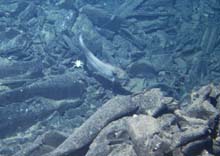
Fish may blend with the background color, but most crustaceans in these environments are white and easy to see. With the absence of natural light, the value of coloration may be low. Photo: C. McLean Click image for larger view.
Temperature Anomolies Worth Investigating
May 29, 2002
Night operations of ABE, CTD tows, and the deep camera tow system all generated good results. When these systems indicate a normal bottom temperature, we know that hydrothermal activity is not present, and saves significant dive time for the Alvin teams. But when the night deployments reveal temperature anomalies, as they did today, we know something on the bottom is worthy of examination. Today, in the early morning hours after recovery of ABE, maps of the surveyed area were passed down into Alvin as the hatch was being sealed. These maps indicated a temperature anomaly in the vicinity of another historic area of vent activity, but the Rose Garden area is temperature stable, and contained no evidence of previous or active venting. Alvin investigated this other new area and found a very low velocity, low temperature vent, with remarkably little life around it. By this indication, and the glassy appearance of the lava formations around it, we believe it to be a young vent area, not yet inhabited by the typical community of organisms with which we have now become familiar. During the dive, scientists conducted a live interview from Alvin, and at the shipboard lab, with members and press at the meeting of the American Geophysical Union. After the discovery of the new vent and the recovery of Alvin, the Atlantis made way for a location along the Galapagos Rift about 180 nautical miles west, for an area that has never been explored before. We will be exploring a new area of this rift for the first time, beginning tomorrow. What will we find?
Sign up for the Ocean Explorer E-mail Update List.















